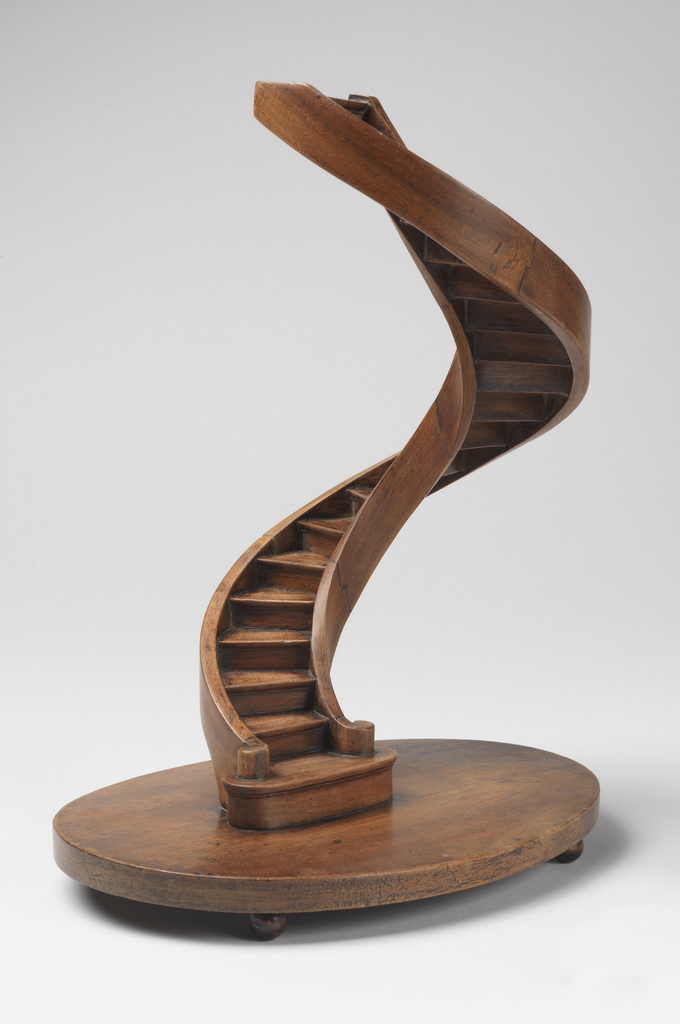This seemingly simple model is actually one of the most accomplished of the staircase models produced in the compagnonnage tradition in France during the late eighteenth to early twentieth centuries. This meritocratic system of craftsmanship outside the traditional guilds started in the middle ages but reached its zenith after the French revolution when royal patronage and the traditional guild system of the ancien regime were not as firmly entrenched. Nonetheless existing guild rules that excluded those who did not work on a father-to-son or other selective apprenticeship, meant that members of these almost secret societies of craftsmen tended to live on the edge of the mainstream.
The compagnons often adopted a symbolic name representing both an emblematic virtue or attribute and a place of origin, such as Languedoc, la Clef des Coeurs (Languedoc, the Key to Hearts) or Blois, Ami du Trait (Blois, Friend of Design Drawing). In the nineteenth century, the mystery associated with these symbolic names—sometimes used to avoid identification in moments of social unrest—and the secret rites often associated with compagnonnage guild-like groups, including ceremonies involving the transfer of special walking sticks with symbols and the wearing of sashes, caused many people to regard them with suspicion. In 1839, attempting to reinforce moral and professional standards for compagnonnage members, Agricole Perdiguier (1805–1875) wrote Le livre du compagnonnage (The Book of Compagnonnage) detailing the movement’s customs and duties. In the fervor of social romanticism characteristic of the time, Perdiguier’s book was enthusiastically received by the great French authors Alphonse de Lamartine and Victor Hugo. In 1841, the French writer George Sand further made Perdiguier and compagnonnage popular cultural icons through her book Le compagnon du tour de France (The Companion of the Tour of France). Perdiguier’s talents as a true master, along with the fame brought on by Sand, drew attention to some of the great works being produced by compagnonnage members and resulted in a revival of interest in their work. He was also the creator of one of the most perfect examples of a model of this form of spiral staircase. His fame and popularity led it to be widely imitated among followers, in this case, highly successfully.
In the compagnonnage system, apprentices honed their skills in a workshop during the day, taking courses in the art of geometrical drawing and design in the evening, and living together in a boarding house-very definitely companions. First, concepts were taught- then the handiwork, both of which became increasingly sophisticated. Each successful member made a ‘tour de France’, working and studying under masters in major centers like Tours, Marseilles, and Lyon. He (no women were permitted) produced an acceptance masterpiece to show mastery of a variety of complicated concepts and techniques at the end of his tour to be accepted as a master in his own right. Later, to show the pleasure at the creation, a master might produce a ‘maitrise’ or masterwork. Sometimes, these were produced as competitions to be named the best, and possibly only, master of a city. Other times, there might be group works for parade. Most of the staircase models thus produced were by masters of woodworking-joiners,cabinetmakers and/or carpenters. This model shows the cabinetmaking skills of joining, carving and turning as well as the design skills to make a graceful self-supporting spiral.
The idea of the spiral was part of the history of real staircases. After originally being exterior to a building, and often hidden for defense, staircases moved to the interior and became helixes, double helixes and multi-tiered cantilevered creations of status rather than of fortification. They added sculptural grace to both the building and those who used them. This model shows that sculptural grace.
This architectural model will be on view beginning December 12th in the Models & Prototypes Gallery, one of Cooper Hewitt’s opening exhibitions.
Sarah D. Coffin is Head of the Product Design and Decorative Arts Department. She curated the exhibition Made to Scale: Staircase Masterpieces The Eugene and Clare Thaw Gift.

One thought on “The Perfect Spiral”
Daniel Morton on January 5, 2015 at 5:22 pm
I made a freestanding Spiral Which could be used for a staircase.